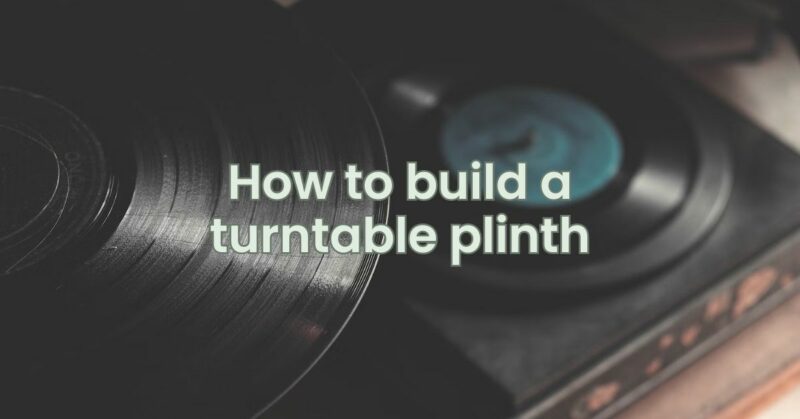For vinyl enthusiasts, the turntable plinth is more than just a supporting structure; it plays a crucial role in isolating the turntable from vibrations and resonances, ultimately contributing to improved sound quality. Building your own turntable plinth can be a rewarding and fulfilling project, allowing you to customize the design and materials to suit your preferences. In this DIY guide, we will walk you through the step-by-step process of building a turntable plinth, helping you elevate your vinyl listening experience and create a unique centerpiece for your analog setup.
Materials and Tools Needed:
- High-quality wood or other suitable materials (MDF, acrylic, etc.) for the plinth
- Measuring tape
- Pencil or marker
- Table saw or circular saw
- Router (optional, for precision cuts)
- Sandpaper (various grits)
- Wood glue or adhesive suitable for the chosen material
- Clamps
- Wood screws or other fasteners
- Screwdriver
- Dampening material (foam, rubber, or cork) for the interior
- Finishing material (stain, paint, or veneer) for the exterior
Step-by-Step Guide:
- Measure and Plan: Decide on the dimensions of your turntable plinth, taking into account the size of your turntable and any additional components you plan to incorporate (e.g., motor, tonearm). Sketch out the design and create a blueprint with all the necessary measurements.
- Cut the Plinth Base: Using a table saw or circular saw, cut the base of the plinth to the desired size and shape, following your blueprint. If you need precision cuts, consider using a router with a straight bit for clean edges.
- Create Openings: Measure and mark the positions for any openings you need on the plinth, such as holes for the turntable motor or tonearm. Carefully cut out these openings using the appropriate tools.
- Sand and Smooth: Use sandpaper to smooth the edges and surfaces of the plinth. Start with a coarser grit and gradually work your way up to a finer grit to achieve a smooth finish.
- Assemble the Plinth: Apply wood glue or suitable adhesive to the edges of the plinth pieces and join them together. Use clamps to hold the pieces firmly in place while the adhesive dries. Follow the assembly order as per your blueprint.
- Reinforce the Plinth: If desired, reinforce the plinth by adding interior braces or supports. This step can help further reduce vibrations and resonance for improved sound quality.
- Dampening Material: Line the interior of the plinth with dampening material such as foam, rubber, or cork. This helps isolate the turntable from external vibrations and enhances the overall stability of the plinth.
- Finish the Exterior: Apply your chosen finishing material, such as stain, paint, or veneer, to the exterior of the plinth. This step not only enhances the appearance but also provides protection for the wood or other materials.
- Mount the Turntable: Carefully place your turntable on the plinth, ensuring that it is centered and secure. Use screws or other appropriate fasteners to attach the turntable to the plinth if needed.
- Fine-Tuning: Once your turntable is mounted on the plinth, you may need to fine-tune its setup, such as adjusting the tonearm height, leveling the turntable, and balancing the tonearm.
Conclusion
Building your own turntable plinth is a rewarding DIY project that can significantly enhance your vinyl listening experience. By carefully selecting materials, crafting a solid and stable structure, and implementing proper dampening techniques, you can create a plinth that isolates your turntable from vibrations and resonances, ultimately improving sound quality. Embrace the creativity and customization possibilities this DIY endeavor offers, and enjoy the satisfaction of seeing and hearing the results of your craftsmanship as you immerse yourself in the rich and authentic world of vinyl music.


